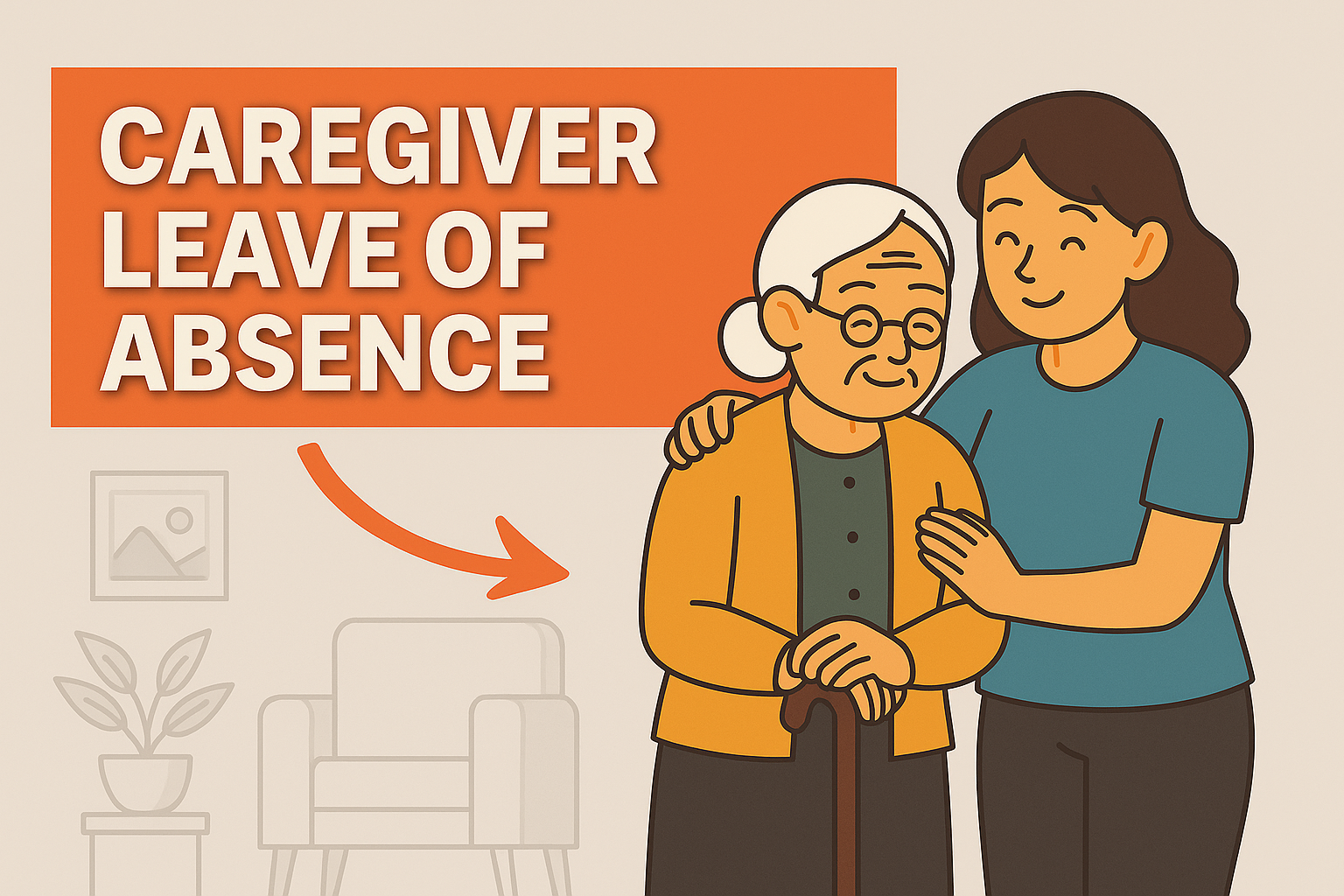Caregiver Leave of Absence
Caregiver Leave of Absence
Caring for a loved one is rewarding but can be challenging when you are balancing work and personal responsibilities. Many family caregivers need time away from work to provide care, especially during medical treatments, recovery periods, or daily support with activities of daily living. A caregiver leave of absence allows employees to step away from their job to care for a family member without losing employment status.
This guide explains what a caregiver leave of absence is, the types available, who qualifies, how to request it, and tips for managing your time away from work.
What Is a Caregiver Leave of Absence?
A caregiver leave of absence is time off from work granted to an employee so they can care for a family member with a serious health condition or special care needs. This leave may be unpaid or paid, depending on state laws, employer policies, or available benefits.
A leave of absence gives you the ability to focus on caregiving duties, such as:
Assisting with bathing, dressing, and mobility
Providing medication management
Attending medical appointments
Offering companionship and emotional support
Coordinating health care and home care services
It ensures you have time to meet your loved one’s needs without risking your job or employee benefits.
Types of Caregiver Leave
Caregiver leave can vary depending on where you live and your employer’s policies. Here are the main types:
1. Family and Medical Leave Act (FMLA)
The FMLA is a federal program that allows eligible employees to take up to 12 weeks of unpaid leave per year to care for a spouse, child, or parent with a serious health condition. Your job is protected during this time, and your health insurance must remain active.
Key points about FMLA caregiver leave:
Applies to employers with 50 or more employees
Requires you to have worked at least 1,250 hours in the past 12 months
Leave may be taken all at once or intermittently
Covers both physical and mental health conditions
2. State-Specific Caregiver Leave Laws
Some states have their own caregiver leave laws that go beyond FMLA. These may provide paid benefits through state disability or family leave insurance programs. Examples include:
California Paid Family Leave
New York Paid Family Leave
New Jersey Family Leave Insurance
Massachusetts Paid Family and Medical Leave
Each state sets its own eligibility rules, wage replacement rates, and maximum leave duration.
3. Employer-Provided Leave
Some employers offer paid caregiver leave as part of their benefits package. This may come in the form of:
Paid time off (PTO) banks
Sick leave policies that include family care
Paid caregiver leave separate from vacation time
Check your employee handbook or talk to HR to understand your options.
Who Qualifies for a Caregiver Leave of Absence?
Eligibility for caregiver leave depends on the program or policy:
Under FMLA: You must meet the work hour requirements and work for a covered employer.
Under state programs: Requirements vary, but you often need a minimum amount of wages earned in the past year.
Employer-provided leave: Each company sets its own rules.
Most programs cover caregiving for:
A spouse or domestic partner
A child (minor or adult with a disability)
A parent (including in-laws in some states)
In certain cases, other relatives or individuals you live with and care for
How to Request a Caregiver Leave of Absence
If you need caregiver leave, follow these steps to make the process smoother:
1. Review Policies and Laws
Start by checking:
Your company’s employee handbook
FMLA eligibility rules
Any applicable state leave laws
This helps you understand your rights and responsibilities.
2. Notify Your Employer
Provide notice as soon as possible. While emergencies happen, giving at least 30 days’ notice is recommended for planned leaves.
3. Provide Required Documentation
Employers may require:
A medical certification form from your loved one’s doctor
Proof of your relationship to the person receiving care
Dates and expected duration of your leave
4. Discuss Coverage and Communication
Work with your manager to arrange coverage for your duties. Decide how you will communicate during leave and confirm how your benefits will be maintained.
Balancing Finances During Caregiver Leave
Since many caregiver leaves are unpaid, planning ahead can help reduce financial stress. Consider:
Using accrued vacation or sick time to supplement income
Applying for state-paid family leave if available
Checking if your employer offers a wage continuation policy
Budgeting for reduced income during your leave
Exploring Medicaid, veteran benefits, or insurance programs for caregiving support
Caring for Yourself While on Leave
A caregiver leave of absence is meant to help your loved one, but it’s also an opportunity to manage your own well-being. Caregiving can be physically and emotionally demanding, so remember to:
Maintain healthy eating habits and regular sleep
Take breaks and use respite care when possible
Stay connected with friends and family for emotional support
Seek help from caregiver support groups or community organizations
Returning to Work After a Caregiver Leave
Transitioning back to work after caregiving can be challenging. To make it easier:
Communicate with your employer before your return date
Ask about flexible schedules or remote work options if ongoing care is needed
Update yourself on workplace changes that happened during your absence
Continue using support resources to manage stress and balance responsibilities
The Value of Caregiver Leave
Caregiver leave is essential for many families, allowing loved ones to receive quality care while protecting the caregiver’s employment and benefits. Whether through federal FMLA protections, state programs, or employer policies, knowing your rights ensures you can take necessary time off without risking your livelihood.
If you are caring for a loved one and need more information on paid caregiver programs, benefits, or eligibility, Paid.Care can help guide you through the process and connect you with resources that make caregiving more manageable.
Final Thoughts
A caregiver leave of absence is more than just time away from work — it’s a lifeline for families facing health challenges. By understanding your options, preparing your finances, and taking care of yourself, you can make the most of your leave while providing the care your loved one needs.
Paid.Care is here to support family caregivers with information, resources, and programs to help you get the assistance you deserve.
FAQs
-
The length of leave depends on the program you use. Under the federal Family and Medical Leave Act (FMLA), eligible employees can take up to 12 weeks of unpaid, job-protected leave in a 12-month period. Some states offer their own paid family leave programs with set time limits, often ranging from 6 to 12 weeks. Employer-provided leave policies may offer different timeframes, so it’s important to check your company’s rules and any applicable state laws.
-
Many caregiver leave options under FMLA are unpaid. However, some states have paid family leave programs that provide partial wage replacement while you are away from work caring for a loved one. Employers may also allow you to use paid time off, sick days, or vacation time to receive income during your leave. If you are caring for a veteran or a Medicaid-eligible family member, you may be able to access additional caregiver pay programs.
-
Yes. For planned medical care or treatment, you should provide at least 30 days’ notice when possible. If the leave is needed unexpectedly, notify your employer as soon as you can. Most employers will require you to submit documentation, such as a medical certification from your loved one’s health care provider, along with the expected dates of leave.
-
Under FMLA, your job is protected, and your employer must maintain your group health insurance during the leave as if you were still working. State-specific programs often have similar protections. However, unpaid leave may require you to continue paying your share of insurance premiums. Always confirm coverage details with your HR department to avoid gaps in health insurance or other employee benefits.




